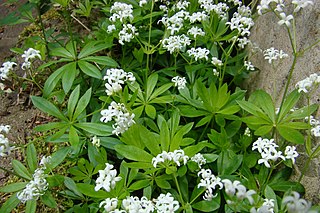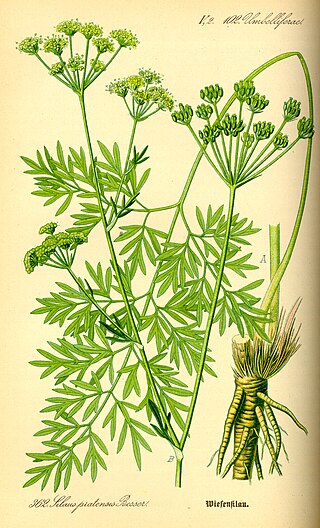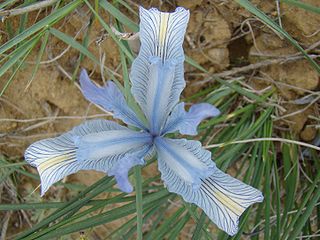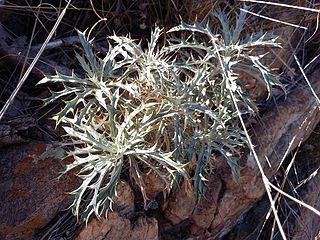
Chervil, sometimes called French parsley or garden chervil, is a delicate annual herb related to parsley. It was formerly called myrhis due to its volatile oil with an aroma similar to the resinous substance myrrh. It is commonly used to season mild-flavoured dishes and is a constituent of the French herb mixture fines herbes.

Galium odoratum, the sweet woodruff or sweetscented bedstraw, is a flowering perennial plant in the family Rubiaceae, native to much of Europe from Spain and Ireland to Russia, as well as Western Siberia, Turkey, Iran, the Caucasus, China and Japan. It is also sparingly naturalised in scattered locations in the United States and Canada. It is widely cultivated for its flowers and its sweet-smelling foliage.

Imperatorin is a furocoumarin and a phytochemical that has been isolated from Urena lobata L. (Malvaceae), Angelica archangelica, Angelica dahurica, Glehnia littoralis, Saposhnikovia divaricata, Cnidium monnieri, Incarvillea younghusbandii, and Zanthoxylum americanum mill. It is biosynthesized from umbelliferone, a coumarin derivative.

Lithospermum officinale, or common gromwell or European stoneseed, is a flowering plant species in the family Boraginaceae, native to Eurasia. It is the host plant for caterpillars of the monophagous moth Ethmia dodecea.

Codiaeum variegatum is a species of Codiaeum, a genus of flowering plants, in the Euphorbiaceae. Initially described by Carl Linnaeus in 1753, it is native to Australasia and Oceania, from Malaysia and Indonesia in the north through northeastern Australia, as well as many Southeast Asian and South Pacific islands, growing in open forests and scrub.

Crinum asiaticum, commonly known as poison bulb, giant crinum lily, grand crinum lily, or spider lily, is a plant species widely planted in many warmer regions as an ornamental. It is a bulb-forming perennial producing an umbel of large, showy flowers that are prized by gardeners. However, all parts of the plant are poisonous if ingested. Some reports indicate exposure to the sap may cause skin irritation.

Bromus ciliatus is a species of brome grass known by the common name fringed brome. It is native to most of North America, including most of Canada, most of the United States except for some portions of the South, and northern Mexico. It is a plant of many habitats, including temperate coniferous forest. The specific epithet ciliatus is Latin for "ciliate", referring to the delicate hairs of the leaf blades.

Osthol, or osthole, is a chemical compound which is a derivative of coumarin. It is found in a variety of plants including Cnidium monnieri, Angelica archangelica and Angelica pubescens.

Daphnin is a plant toxin with the chemical formula C15H16O9 and is one of the active compounds present in the Eurasian and North African genus Daphne of the Thymelaeaceae, a plant family with a predominantly Southern Hemisphere distribution with concentrations in Australia and tropical Africa.

Melica ciliata, the hairy melic or silky spike melic, is a species of flowering plant in the grass family Poaceae, native to Europe, north Africa and temperate Asia. It has been introduced to South Australia.

Leucas aspera is a plant species within the genus Leucas and the family Lamiaceae. Although the species has many different common names depending on the region in which it is located, it is most commonly known as Thumbai or Thumba. Found throughout India, it is known for its various uses in the fields of medicine and agriculture.

Flemingia vestita, famously known as sohphlang, is a nitrogen fixing herb with characteristic tuberous root, belonging to the genus Flemingia. The root is edible and is a common vegetable in some Asian tribal communities. In addition, it has been traditionally used as an anthelmintic, the basis of which is scientifically validated.

Silaum silaus, commonly known as pepper-saxifrage, is a perennial plant in the family Apiaceae (Umbelliferae) found across south-eastern, central, and western Europe, including the British Isles. It grows in damp grasslands on neutral soils.

Digitaria insularis is a species of grass commonly known as sourgrass. It is native to Central and South America and the southern parts of the United States and has been introduced into other parts of the world. It was first described by the German botanist Friedrich Karl Georg Fedde in 1904.

Tetradium ruticarpum is a tree that comes from China and Korea. It was previously classified in the genus Euodia as Euodia ruticarpa. The fruit is usually used, denoted sometimes as fructus. It has a strong bitter taste, and is used in traditional Chinese medicine (TCM) and is a recognized herb in Kampo. Both the former genus name and the species name are often misspelled, and the plant usually appears in sources dealing with traditional Chinese medicine as "Evodia(e) rutaecarpa".

Iris tenuifolia is a beardless iris in the genus Iris, in the subgenus Limniris and in the series Tenuifoliae of the genus. It is a rhizomatous herbaceous perennial, from a wide region over central Asia, including Afghanistan, Pakistan, ; Kazakhstan, Uzbekistan and Mongolia and in China. It has long greyish-green leaves, short stem and pale violet, lilac, pale blue, or purple flowers.

Berkheya carlinopsis Welw. ex O.Hoffm. is a Southern African herb or subshrub belonging to the family Asteraceae and was first described in 1896 in Boletim da Sociedade Broteriana 13 34.
A perennial herb or subshrub up to c. 1.5 m. tall. Stems branched, whitish araneose-tomentose, or glabrescent, leafy. Leaves sessile, 3–6 cm. long, dentate to pinnatifid-dentate; lamina 2–3(4) mm. wide and linear or 5–15 mm. wide and lanceolate; teeth 3–8 on each side, each tooth 2–6(10) mm. long, triangular or linear and extended in a tawny spine 2–3 mm. long; margins of teeth and sinuses entire or armed with smaller spines; upper surface smooth or somewhat scabrous, slightly to densely araneose-tomentose or glabrescent; lower surface whitish felted-tomentose. Capitula radiate, solitary and terminal on the branches, or subcorymbosely arranged, 2.5–5(+?) cm. in diam. including the rays. Phyllaries spreading, felted-tomentose outside, subglabrous or glabrous inside, 10–20 x 1–3 mm., linear-lanceolate, spiny-acuminate, ciliate-spinescent on the margins with spines 1–3 mm. long; the outermost phyllaries ± leaf-like with small spine-tipped teeth; inner phyllaries smaller and less spinescent-ciliate. Margins of the receptacular alveolae extended into straw-coloured bristles 1–2 mm. long. Achenes 1.5–3.5 mm. long, turbinate, 8–10-ribbed, strigose-sericeous, glandular-viscid at the apex. Pappus scales 2-seriate, 1–1.5 mm. long, narrowly oblong, acute or subobtuse, denticulate towards the apex.

Xanthosia atkinsoniana, is a small herb in the family Apiaceae. It grows in both New South Wales and Western Australia.

Tricoryne elatior is a species of flowering plant in the family Asphodelaceae, native to Australia, and found in all its states and territories.

Sphenopholis intermedia, the slender wedgegrass or slender wedgescale, is an annual grass native to North America. The specific epithet "intermedia" means "intermediate". The diploid number is 14.



















